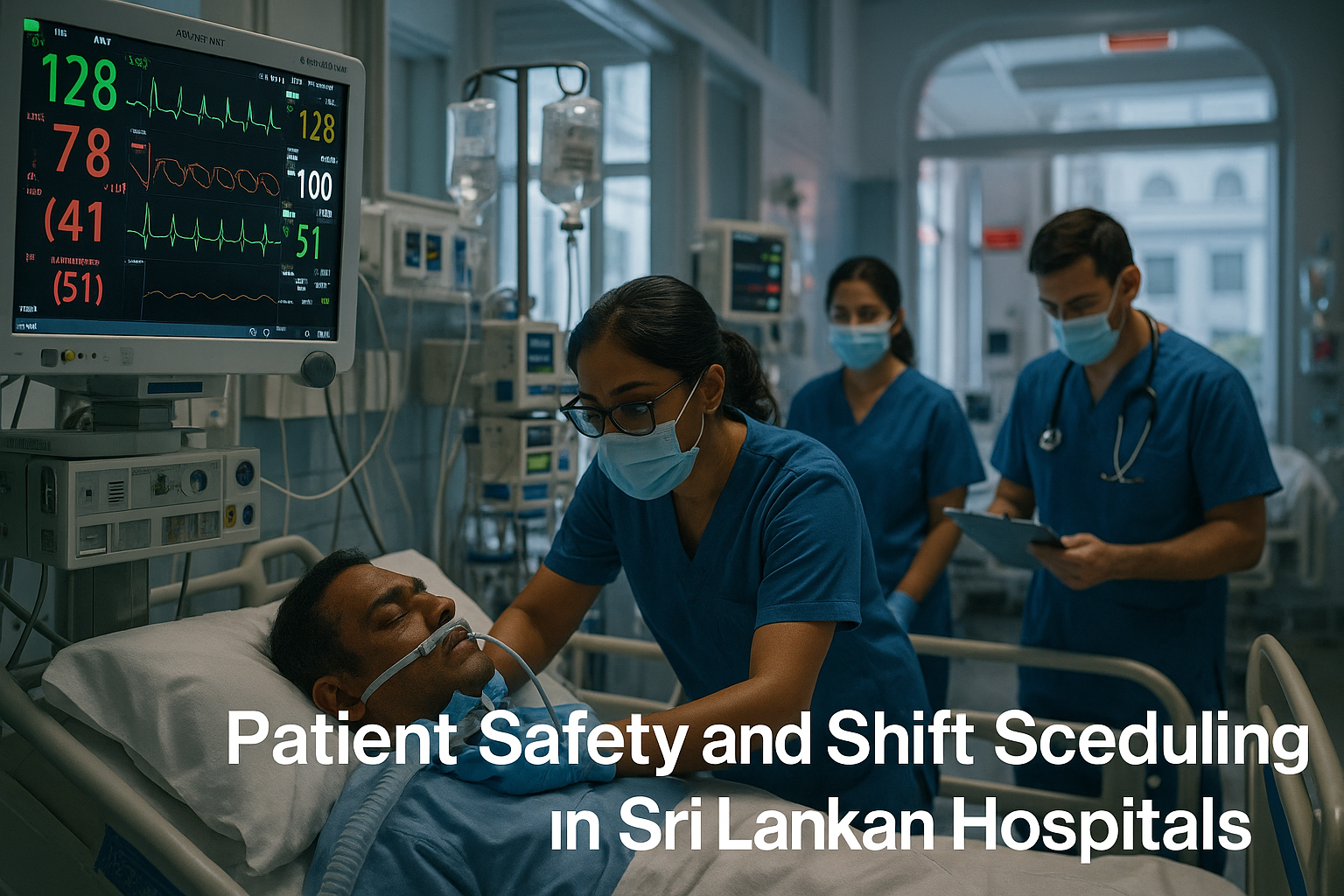Your basket is empty
Already have an account? Log in to check out faster.
Already have an account? Log in to check out faster.

The deadly scheduling mistakes happening in Sri Lankan hospitals right now – and the life-saving solution
2:17 AM, Cardiac ICU at a major Colombo hospital:
A 65-year-old patient goes into cardiac arrest. The night nurse rushes to respond, but she's already been on duty for 14 hours covering for a colleague who didn't show up. Her exhaustion causes a critical 30-second delay in administering medication. Meanwhile, the specialized cardiac nurse who should be here is stuck in another ward because the scheduling system assigned her to two places at once.
This isn't a rare incident. It's happening every night across Sri Lankan hospitals where outdated scheduling systems are literally putting lives at risk.
Last month, three preventable medical errors occurred in Sri Lankan hospitals due to scheduling-related staffing issues. Two resulted in extended patient stays. One was nearly fatal.
Medical errors are the 3rd leading cause of death globally. While everyone focuses on equipment and protocols, a hidden killer lurks in hospital corridors: chaotic shift scheduling that creates dangerous staffing situations.

The life-threatening scheduling failures include experienced nurses forced into 16+ hour shifts due to no-show coverage, critical care units understaffed because specialized nurses are scheduled elsewhere, medication errors increasing by 40% during poorly managed shift changes, and emergency situations lacking proper response because qualified staff aren't where they should be.
Patient safety incidents directly linked to scheduling chaos include delayed emergency responses when on-call systems fail, medication administration errors during confusing shift handovers, patient falls and injuries due to inadequate floor coverage, and infection control breaches when cleaning and safety protocols are missed during understaffed periods.
Poor scheduling creates a cascade of safety risks. Exhausted nurses make more mistakes – studies show error rates increase 300% after 12+ consecutive work hours. Understaffed units cut corners on safety protocols to manage patient loads. Inexperienced staff in critical areas make decisions beyond their competency level. Communication breaks down during chaotic shift changes leading to missed patient information.
Sri Lankan hospitals face additional safety compliance challenges including Ministry of Health nurse-to-patient ratio requirements varying by department, SLMC-mandated continuing education that must be scheduled without compromising coverage, emergency protocol compliance requiring specific trained personnel on duty, and infection control standards demanding consistent staffing for proper hygiene protocols.
Leading healthcare providers across Sri Lanka have discovered that proper shift scheduling isn't just about convenience – it's about patient survival.
Real-Life Safety Transformation:
Lanka Hospitals - Tertiary Care Center 280 nursing staff, 24/7 critical care operations
Before Gallery ERP:
After Gallery ERP:

Medical Director's Quote: "We went from constantly worrying about whether we had the right nurses in the right places to having complete confidence in our coverage. It's transformed our entire approach to patient safety."
Gallery ERP's life-saving scheduling features include smart shift optimization ensuring qualified nurses in critical departments, fatigue prevention systems blocking dangerous overtime accumulation, emergency coverage protocols with instant backup notification, and real-time compliance monitoring maintaining Ministry of Health staffing requirements.
The system includes critical safety capabilities such as specialized certification matching preventing unqualified staff in high-risk areas, handover documentation ensuring critical patient information transfers safely between shifts, break scheduling maintaining continuous coverage without compromising patient monitoring, and incident tracking linking scheduling patterns to safety outcomes for continuous improvement.
How proper scheduling directly saves lives: Rested, alert nurses make fewer critical errors during medication administration and patient monitoring. Appropriate staffing levels ensure immediate response to patient emergencies. Qualified personnel in specialized units prevent complications requiring intensive interventions. Smooth shift transitions maintain continuity of care and prevent information gaps.
The safety improvements are measurable and dramatic. Medical error rates decrease by 45% when proper staffing protocols are followed, patient satisfaction scores improve by 35% with consistent, adequate nursing coverage, emergency response times improve by 60% when qualified staff are properly positioned, and regulatory compliance incidents drop to near zero with automated monitoring.
Implementation prioritizes patient safety from day one. It starts with critical care areas and emergency departments where lives are most at risk, gradually expands to general wards with full safety protocol integration, and includes comprehensive staff training on new safety-focused scheduling procedures.
The Life-or-Death Reality: Every scheduling mistake in a hospital has potential life-threatening consequences. A cardiac nurse stuck in pediatrics during a heart attack. An ICU specialist forced into overtime making medication errors. An understaffed emergency room during a trauma case.
These aren't theoretical risks – they're happening right now in hospitals struggling with manual scheduling systems that can't handle the complexity of modern healthcare.

Sri Lankan hospitals have two options: continue risking patient lives with chaotic scheduling, or implement proven systems that prioritize both staff wellbeing and patient safety.
The most respected healthcare providers in the country have already made their choice. They've eliminated scheduling-related safety risks and are setting new standards for patient care excellence.
Patient safety isn't negotiable. Your scheduling system shouldn't be either.
Ready to eliminate scheduling-related safety risks and join Sri Lankan hospitals leading in patient care excellence? Schedule your critical care assessment with Gallery ERP and discover how proper workforce management can be the difference between life and death.

Don’t miss this opportunity to upgrade your HR operations and join the growing list of businesses in Sri Lanka achieving success with GalleryHR.
GalleryHR is committed to helping Sri Lankan businesses thrive with smarter, more efficient HR solutions. Partner with us today and experience the difference.
Join our empire today!































0 comments